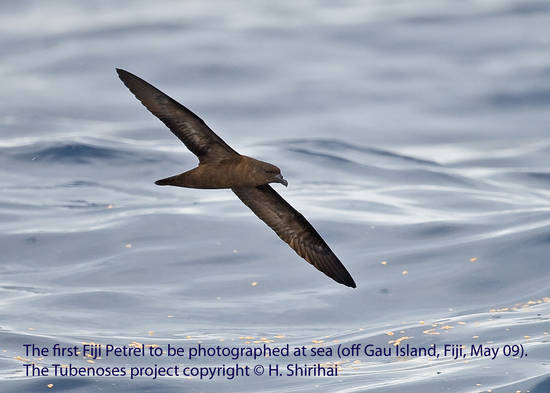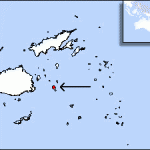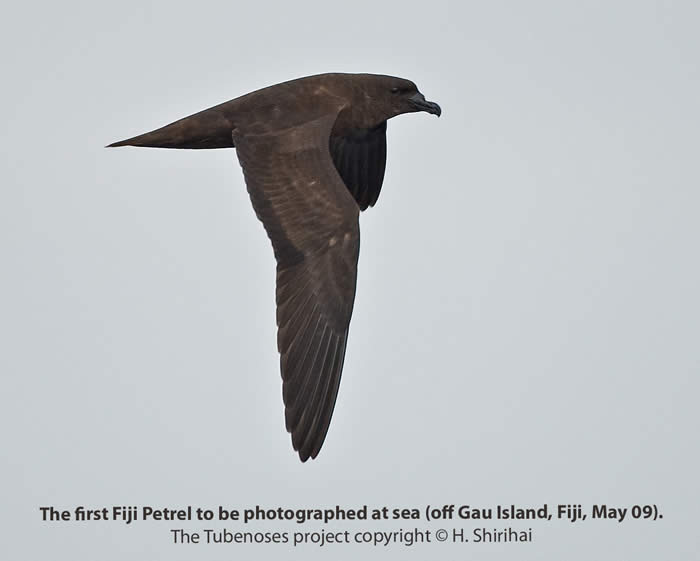Tony Pym reports from the Fiji Petrel Expedition.
With an attempt to put some content on my always too unfrequent blog, I have decided to share birding news that come my way. I have previously posted to posts on this fascinating expedition. The first was a summery of the planning and execution of the discovery of Fiji Petrel. The second an interview with the expedition leaders Hadoram Shirihai and Tony Pym.
Here is a report from Tony Pym from the The Fiji Petrel Expedition published on the listserver Seabird-News on Sep 18 of significant sightings recorded between May 12-22, 2009 near Gau island. Observers were Hadoram Shirihai, Tony Pym, Joerg Kretzschmar and Dick Watling. The records clearly indicate why the observers consider this marine area a new and important hotspot for seabirds.
MURPHY’S PETREL: One photographed on 16 May. There are no known records from Fiji and the literature suggests this record is also the first for the Western Pacific. This is an extraordinary record of vagrancy for a species that breeds no closer than the western Tuamotu Archipelago (2,000 km. to the east of Fiji), with usual migration to the north and east of the breeding islands.
KERMADEC PETREL: Birds varied from very pale to all dark. We observed this species in 2005, 2008 and 2009 and believe it to be regular in Fiji waters, and that it may breed.
PHOENIX PETREL: One, on 21 May, is apparently the first confirmed record for Fiji waters.
MOTTLED PETREL: This long-distance migrant moves from breeding grounds in New Zealand to the North Pacific, but has seldom been recorded in Fiji waters. It was seen (and photographed) almost daily during the expedition in 2009.
WHITE-NECKED PETREL: One briefly inspected the chum on 18 July 2008. The bird might have been a Vanuatu Petrel P. occulta, although it was seen alongside several other species and considered too large. Both species can be expected in Fiji waters.
BLACK-WINGED PETREL: Two; one in heavy moult (14 May), the other fresh plumage (16 May). The species’ status is uncertain in Fiji waters, where it is little known, despite breeding as close as New Caledonia, Tonga and the Kermadec Islands.
GOULD’S PETREL: A few seen, almost daily during the expedition, amongst the many P. brevipes, with which it was considered conspecific in the past. All were P. l. caledonica. The paucity of records in Fiji waters may be attributable to a lack of knowledge in separating it from pale-phase P. brevipes. The possibility that P. leucoptera also breeds in Fiji cannot be excluded as apart from New Caledonia, Cabbage Tree Island (NSW, Australia), and possibly Vanuatu, the species has now been found breeding far to the east, in south-east (French) Polynesia (Bretagnolle et al. in prep.).
COLLARED PETREL: Numbers increased during the late afternoons, suggesting most were breeding birds returning to Gau. 10% were the dark-bellied morph.
TAHITI PETREL: The most frequent petrel. Most are believed to breed in northern Fiji e.g. on Taveuni.
PARKINSON’S (BLACK) PETREL: Our observation on 17 May, of this New Zealand endemic breeder, is the first for Fiji waters.
CHRISTMAS (KIRITIMATI) SHEARWATER: A bird seen en route to Gau, 12 May, is the second for Fiji waters.
WEDGE-TAILED SHEARWATER: Breeds on many islands in Fiji, but relatively few seen (c. 30), all were dark morph, and we are unaware of pale forms in the region.
BULLER’S SHEARWATER: Observed on two days during the 2009 expedition – only three previous records in Fiji waters.
SOOTY SHEARWATER: Few seen on most days during the expedition. Some showed quite dark underwings, had apparently short bills, and their feet projected beyond the tail in flight. We mistook some as Short-tailed Shearwaters, and these odd birds require future attention. Both shearwaters are regular in Fiji waters.
FLESH-FOOTED SHEARWATER: Surprisingly, our 21 May sighting is only the second in Fiji waters; the first was a bird captured off Gau, also this year (February 2009).
WILSON’S STORM PETREL: Observed on four days, always at the chum.
WHITE-FACED STORM PETREL: A single on 16 May had the pale, virtually whitish-grey, rump
usually associated with P. (m). albiclunis, which breeds on the Kermadec Islands, New Zealand and possibly Norfolk Island, Australia.WHITE-BELLIED STORM PETREL: We photographed the first for Fiji waters, in July 2008, off Taveuni Island.
BLACK-BELLIED STORM PETREL: One on 16 May at the chum, the second confirmed record in Fiji waters.
POLYNESIAN STORM PETREL: This attractive storm petrel was first recorded in Fiji from a bird taken on the nest in September 1876 on Kadavu Island. There were no further confirmed records until 19 July 2008 when we photographed a bird at chum, and then another was seen on 14 May 2009.
MATSUDAIRA’S STORM PETREL: The first record for Fiji waters of this Japanese breeder (and Indo-Pacific migrant) was on 13 May. The closest region from where the species is regular is the Bismarck Archipelago, Papua New Guinea.



